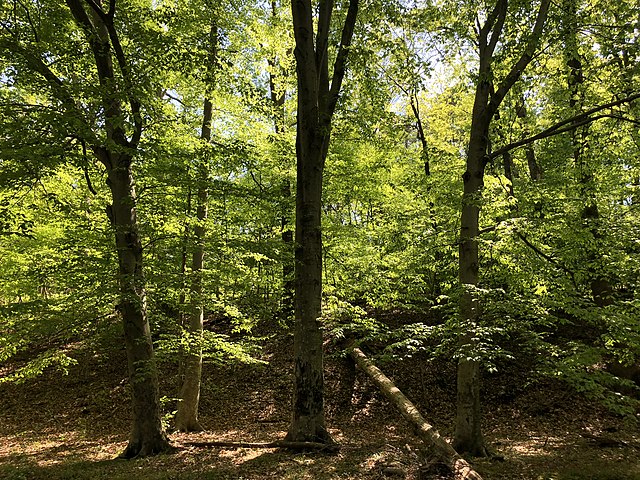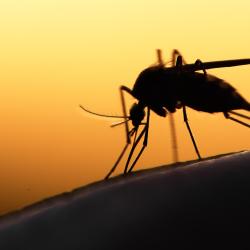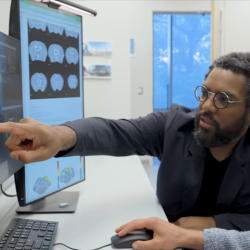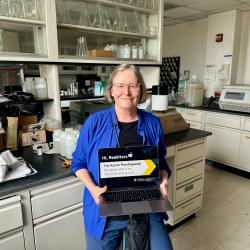Looking Up: Maryland’s Forests and COVID-19
UMD-Smithsonian study looks at effect of reduced pollution due to COVID-19 on Maryland’s trees
From the time he was a kid spending summers hiking with his grandfather, Nathan Swenson has always loved trees.
“There’s just something about trees that calms me,” he said. “It feels like home to me to be in a forest.”
Now, as a professor in the University of Maryland’s Department of Biology, Swenson sees trees and forests from a more analytical perspective.
“When I look at trees now, I think about what parts of their morphology and physiology can help me understand why they are where they are and whether they’re doing well or not doing so well and what might cause that,” Swenson said.
For the last three years, Swenson partnered with Sean McMahon of the Smithsonian Environmental Research Center to study tree growth in forests in eastern North America, sampling trees during the May to August growing season to see how trees and forested ecosystems respond to the atmosphere and stresses around them. For trees in the D.C.-Maryland-Virginia (DMV) region, air pollution takes an unhealthy toll.
“You can watch the trees kind of struggle their way through the year,” Swenson explained. “Day to day at normal activity the trees are experiencing a fairly high level of pollution in the DMV. So, during the growing season you’ll see kind of a degeneration of their leaves due to age but also pollutants in the air.”
This year, COVID-19 changed everything. With significant limits on normal activities due to the pandemic, the Maryland Department of the Environment reported a dramatic drop in atmospheric pollutants in the region. For Swenson’s tree research, that presented a once-in-a-lifetime opportunity.
“When COVID hit, my collaborator at the Smithsonian called up and said, ‘Hey, the air quality is fantastic this year because no one is moving around, I wonder what the trees are doing,’” Swenson said.
Now, Swenson and his colleagues at the Smithsonian are working to answer that question. In April, they were awarded a RAPID Response Grant from the National Science Foundation for a yearlong tree study. They will investigate what happens to trees that have been exposed to—and stressed by—air pollution when air quality improves.
“We’ve been studying these forests in eastern North America for about three years, so we have this nice baseline of what it looks like normally. Now what does it look like if you shut everything off? You can’t really do that study unless you know what was going on in the first place,” Swenson said.
 Swenson’s new research focuses on two of Maryland’s most familiar trees—the American beech, a smooth-bark tree seen in old-growth forests on the East Coast, and the red maple, one of the most common trees in the United States. More than just being aesthetically pleasing, these trees are part of a bigger environmental picture, because of their ability to take carbon from the atmosphere and contribute to a healthier climate.
Swenson’s new research focuses on two of Maryland’s most familiar trees—the American beech, a smooth-bark tree seen in old-growth forests on the East Coast, and the red maple, one of the most common trees in the United States. More than just being aesthetically pleasing, these trees are part of a bigger environmental picture, because of their ability to take carbon from the atmosphere and contribute to a healthier climate.
“I’m interested in trees because I love trees, but the broader implications are also certainly important,” said Swenson. “How are the trees responding? How much carbon can they fix? How much healthier are the trees if we have this kind of reduced atmospheric pollution? All these things are important for us to know, especially because these two particular species are important to eastern North America and affect what our forests might look like in the future.”
Over the next year, Swenson’s colleagues at the Smithsonian Environmental Research Center will use two different field research techniques to gather information for this tree study. Small metal bands placed on each tree will help determine, over time, how much the trunk expands and how much each tree grows. Using more advanced analytical tools, the researchers will assay the gene expression of the leaves to determine how they’re responding to recent changes in their environment—including the reduced level of atmospheric pollutants—during their growing cycle.
“One of the things we’re interested in is some of the repair mechanisms that we might see triggered in a leaf,” Swenson explained. “A leaf under normal circumstances a couple of years ago would get damaged as the growing season progressed due to pollutants in the air. This year, we might expect less activity inside the leaf with respect to repair mechanisms that a tree might use to kind of fix itself as the growing season moves on.”
Based on what he has learned from his previous research, Swenson believes the reduction in air pollution due to COVID-19 will have a major effect on Maryland’s forests.
“We’re hypothesizing that the forests are going to perform better,” Swenson said. “There are fewer pollutants in the air, less things like nitrogen dioxide, so the trees should be actually enjoying the good life right now, contrary to everybody else. In normal years, when there’s really high particulate matter and other compounds in the air, the trees would not be doing so hot.”
The results of this study are months away, but they may one day provide important information for policymakers on what could happen with a dramatic reduction of emissions in the DMV.
“If we suddenly had a really high fraction of the Beltway traffic turn into electric vehicles and we started generating energy in alternative ways, you could start doing projections and say, ‘This is how the trees would perform, this is how much carbon they would fix by growing their trunks, and this is how their leaves would physiologically respond,’” Swenson explained. “It kind of gives us a snapshot of what that future could be like. But we have a lot of work to do to get there.”
###
Media Relations Contact: Leslie Miller, 301-405-9267, lmille12@umd.edu
University of Maryland
College of Computer, Mathematical, and Natural Sciences
2300 Symons Hall
College Park, Md. 20742
www.cmns.umd.edu
@UMDscience
About the College of Computer, Mathematical, and Natural Sciences
The College of Computer, Mathematical, and Natural Sciences at the University of Maryland educates more than 9,000 future scientific leaders in its undergraduate and graduate programs each year. The college's 10 departments and more than a dozen interdisciplinary research centers foster scientific discovery with annual sponsored research funding exceeding $200 million.








